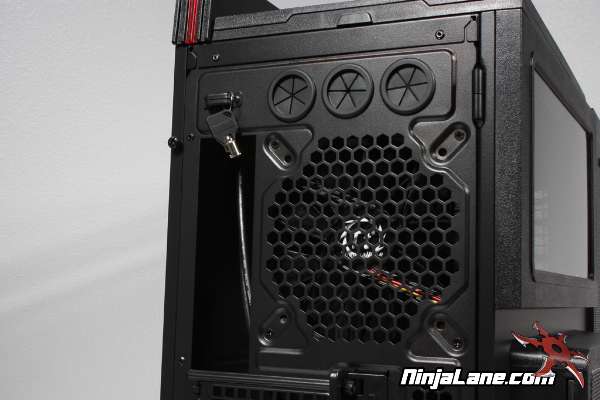Thermaltake Level 10 GT Case Review
Author: Dennis Garcia
Published: Tuesday, July 26, 2011
Case Layout and Features Cont.
Cable management is a snap with the Level 10 GT due to there being a 3/4" space between the motherboard tray and the embossed back panel. Rubber grommets help to protect and conceal the various openings located along the edge of the motherboard tray and near the power supply.
You will also find a rather large opening in the motherboard tray to help in accessing the back of the motherboard for heatsink swaps.
We installed an Asus P8P67 Evo motherboard to check clearances around the various case components. The P8P67 PCB is a standard ATX size which puts it right in line with the available cables channels. Extended ATX motherboards are also supported up to a maximum width of 13".
We installed an Asus P8P67 Evo motherboard to check clearances around the various case components. The P8P67 PCB is a standard ATX size which puts it right in line with the available cables channels. Extended ATX motherboards are also supported up to a maximum width of 13".
This next feature is a great addition for those of you who like to run a multitude of graphics cards and are fed up with only having seven slots available. On the Level 10 GT you will find eight expansion slots which allow you to run triple and quad GPU systems with dual slot coolers intact.
Back in the early years of casemodding there were two visual indicators you could always rely on to separate a good case from a bad one. The first was case material. If the metal had a flat grey look then it was SECC steel and could stand up to years of abuse and extensive modding. The second was the condition of the expansion slots. If the card screws were inside the case it was from a quality builder who cared about their products. "Pot metal" builders would often have these screws on the outside of the case and make you deal with a cover plate to cover for their laziness to create a proper expansion slot stamp.
Sadly the Level 10 GT fails the internal screw test.
Back in the early years of casemodding there were two visual indicators you could always rely on to separate a good case from a bad one. The first was case material. If the metal had a flat grey look then it was SECC steel and could stand up to years of abuse and extensive modding. The second was the condition of the expansion slots. If the card screws were inside the case it was from a quality builder who cared about their products. "Pot metal" builders would often have these screws on the outside of the case and make you deal with a cover plate to cover for their laziness to create a proper expansion slot stamp.
Sadly the Level 10 GT fails the internal screw test.

You will find 3 external watercooling and cable ports above the rear facing 140mm exhaust fan.





